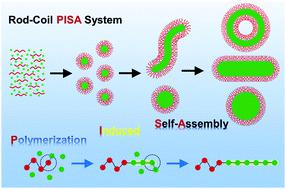当前位置:
X-MOL 学术
›
Soft Matter
›
论文详情
Our official English website, www.x-mol.net, welcomes your
feedback! (Note: you will need to create a separate account there.)
Rod–coil block copolymer aggregates via polymerization-induced self-assembly
Soft Matter ( IF 2.9 ) Pub Date : 2020-03-16 , DOI: 10.1039/d0sm00244e Yisheng Lv 1, 2, 3, 4, 5 , Liquan Wang 1, 2, 3, 4, 5 , Fan Liu 1, 2, 3, 4, 5 , Weisheng Feng 1, 2, 3, 4, 5 , Jie Wei 1, 2, 3, 4, 5 , Shaoliang Lin 1, 2, 3, 4, 5
Soft Matter ( IF 2.9 ) Pub Date : 2020-03-16 , DOI: 10.1039/d0sm00244e Yisheng Lv 1, 2, 3, 4, 5 , Liquan Wang 1, 2, 3, 4, 5 , Fan Liu 1, 2, 3, 4, 5 , Weisheng Feng 1, 2, 3, 4, 5 , Jie Wei 1, 2, 3, 4, 5 , Shaoliang Lin 1, 2, 3, 4, 5
Affiliation

|
Polymerization-induced self-assembly (PISA), incorporating the polymerization with in situ self-assembly, can achieve nano-objects efficiently. However, the cooperative polymerization and self-assembly lead to unclear polymerization kinetics and aggregation behavior, especially for the systems forming rigid chains. Here, we used dissipative particle dynamics simulations with a probability-based reaction model to explore the PISA behavior of rod–coil block copolymer systems. The impact of the length of macromolecular initiators, the targeted length of rigid chains, and the reaction probability on the PISA behavior, including polymerization kinetics and self-assembly, were examined. The difference between PISA and traditional self-assembly was revealed. A comparison with experimental observations shows that the simulation can capture the essential feature of the PISA. The present work provides a comprehensive understanding of rod–coil PISA systems and may provide meaningful information for future experimental research.
中文翻译:

棒-线圈嵌段共聚物通过聚合诱导的自组装聚集
聚合诱导自组装(PISA),将聚合与原位结合自组装,可以有效地实现纳米物体。然而,协同聚合和自组装导致不清楚的聚合动力学和聚集行为,特别是对于形成刚性链的体系。在这里,我们使用耗散的粒子动力学模拟和基于概率的反应模型来探索棒-卷嵌段共聚物体系的PISA行为。考察了大分子引发剂的长度,目标刚性链的长度以及反应概率对PISA行为(包括聚合动力学和自组装)的影响。揭示了PISA与传统自组装之间的区别。与实验观察结果的比较表明,仿真可以捕获PISA的基本功能。
更新日期:2020-04-24
中文翻译:

棒-线圈嵌段共聚物通过聚合诱导的自组装聚集
聚合诱导自组装(PISA),将聚合与原位结合自组装,可以有效地实现纳米物体。然而,协同聚合和自组装导致不清楚的聚合动力学和聚集行为,特别是对于形成刚性链的体系。在这里,我们使用耗散的粒子动力学模拟和基于概率的反应模型来探索棒-卷嵌段共聚物体系的PISA行为。考察了大分子引发剂的长度,目标刚性链的长度以及反应概率对PISA行为(包括聚合动力学和自组装)的影响。揭示了PISA与传统自组装之间的区别。与实验观察结果的比较表明,仿真可以捕获PISA的基本功能。











































 京公网安备 11010802027423号
京公网安备 11010802027423号